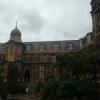
A Potted History
|
The Godwin Laboratory has undergone major changes throughout its history but developed around the pioneering work of Sir Harry Godwin and his quest for an interdisciplinary approach to Quaternary Research. In 1948 he was pivotal in forming the Subdepartment of Quaternary Research as part of the Botany School in Cambridge, England. |
Sir Harry Godwin |
During 1952 Radiocarbon dating equipment was received. Shortly afterwards, 1957, moved to Station Road in part due to safety concerns and the need for more space.
 |
In 1962 the radiocarbon dating equipment was supplemented by the arrival of the first Mass Spectrometer for the laboratory. This marked the beginning of the lab as a stable isotope facility and opened a new avenue for research which in time led to some of the most outstanding research achievements of the laboratory. |
The laboratory was relocated to the New Museums site in 1977 and renamed "The Godwin Laboratory". The move once again made collaboration easier and provided better accommodation for the equipment and staff.
A review of the Subdepartment in 1995 ended with the dissolution of the Subdepartment resulting in the dispersal of different interest groups. The palaeoclimate group was incorporated into the Cambridge University Department of Earth Sciences.
|
In 2006 the Godwin Laboratory mass spectrometry and particle sizing facilities moved to the main building on Downing Site and merged with Harry Elderfield's Geochemistry group and Nick McCave's Sedimentology group. At the same time the laboratory was renamed "The Godwin Laboratory for Palaeoclimate Research". |
|
At the time of dissolution a group known as the Godwin Institue of Quaternary Research was also launched but has since changed name to the Cambridge Institute of Quaternary Research or Cambridge Quaternary in short form. This group still exists and is associated with the Godwin Lab. A link is available via their logo on the home page where there is further information on the details of the former Subdepartment and also on current research interests.
 |
For further information please see the detailed book published by a former Subdepartment Director, Professor Richard West. It details the history of Quaternary Research in Britain and Ireland and has notes on research achievements and certain former members. |
The Development of Research and Changing Institutions
The study of climate history began with studies of pollen records in terrestrial sequences, such as those at Wicken Fen described by Harry Godwin. In the UK, these records typically extended only for a few thousand years, and were well within the time-range measurable by radiocarbon dating. So it made sense to develop chronologies using radiocarbon dating as well as using any other clues to the chronology such as archaeological evidence. When it became possible to measure palaeoclimate in marine cores, using faunal counts and isotopic analyses, the focus of research switched to much longer geological timescales, sometimes spanning several million years, well outside the range of radiocarbon dating. For such sequences, different techniques had to be applied to develop chronologies: radiometric dating using non-radiocarbon techniques, palaeomagnetic and tephra studies, but particularly cyclostratigraphy. Hayes, Imbrie and Shackleton (1976) showed that climate cycles in the marine record could be linked to known changes in the Earth's orbital geometry - the so-called "Milankovitch cycles". The Godwin Laboratory became a primary locus for the development and testing of such chronological models, which in turn led to new insights into the behaviour of the climate system on geological timescales. So the transition from a Plant-sciences to an Earth-sciences based institution had an underlying rationale in terms of the chronological scale of the records being studied.


